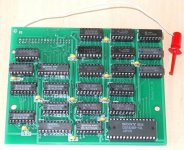TRS-Ian
Veteran Member
The TRS-80 support just continues 
Available from my web site: http://ianmav.customer.netspace.net.au/hires/hires.htm
I am now am taking orders on this great new product, which is a modified version of the HRG I started selling in April, this one re-arranges the components on the PCB so it now fits inside the Model 4P Portable TRS-80:

Here is how it compares to the old µLabs 5.1 HRG which it is based on:

So it fits inside the motherboard cavity like so:

Installation in the Non-gate 4P is easy with only 3 jumpers positions changed after plugging in the PCB and hooking up the fly-lead. Installing into the 4P gate array is even easier with one jumper on the HRG connector removed and just hooking up the fly lead.

This video explains it all:
Cheers,
Ian.
Available from my web site: http://ianmav.customer.netspace.net.au/hires/hires.htm
I am now am taking orders on this great new product, which is a modified version of the HRG I started selling in April, this one re-arranges the components on the PCB so it now fits inside the Model 4P Portable TRS-80:

Here is how it compares to the old µLabs 5.1 HRG which it is based on:

So it fits inside the motherboard cavity like so:

Installation in the Non-gate 4P is easy with only 3 jumpers positions changed after plugging in the PCB and hooking up the fly-lead. Installing into the 4P gate array is even easier with one jumper on the HRG connector removed and just hooking up the fly lead.

This video explains it all:
Cheers,
Ian.
